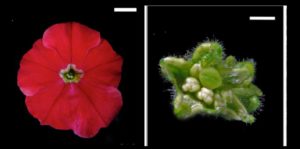BEN, ROB, and the Making of a Petunia Flower
A lot of effort goes into making a flower. Suites of genes must function in the right place at the right time. If not, stamens might grow where sepals should be, and so on, yielding homeotic mutant flowers. In general, flower parts are arranged in four concentric whorls of organs, including (from outside to inside) sepals, petals, stamens, and carpels. Three classes of genes specify floral organ formation: organ-identity genes that activate downstream organ-specific gene expression; boundary-setting genes that restrict the expression of specific genes to the appropriate whorl; and genes required for the initial activation of organ-identity genes. Extensive homeotic mutant analysis gave rise to the venerable ABC model (reviewed in Weigel and Meyerowitz, 1994). Each whorl of a flower is specified by a unique combination of organ identity activities: function A for sepals, A and B for petals, B and C for stamens, and C for carpels. Function A and C mutually repress each other and are carried out by both organ-identity and boundary-setting genes.
B- and C-function genes are conserved in a wide variety of plants, including the rosid species Arabidopsis thaliana and the astrid species Petunia hybrida. However, while the A-function transcription factor gene APETALA2 (AP2) has both organ identity and boundary-setting activities in Arabidopsis (e.g., Wollmann et al. 2010) and acts as the major repressor of C-activity in the outer floral whorls, the equivalent C-repressor function in petunia is encoded by the microRNA BLIND (BL), which likely represses the activity of NF-YA transcription factors (Cartolano et al., 2007). Intriguingly, while petals are converted into stamen-like structures in bl mutants due to the combined expression of B- and C-function genes in the second whorl, the expression of C-function genes in the first whorl does not lead to the conversion of sepals to carpels as predicted by the ABC model, implying that factors besides BL also repress the C-function to prevent carpel development in the first floral whorl of petunia.
 Prompted by this finding, Morel et al. (2017) took advantage of a petunia line with abundant dTph1 transposons to uncover a mechanism controlling the spatial restriction of floral organ-identity genes in petunia. The authors introgressed the bl mutation into this dTph1 line to create new, transposon-tagged mutants. Screening this population for mutations that enhance the bl phenotype led to the identification of ben (for blind enhancer) mutants in the bl background. In ben bl mutants, all sepals are converted into carpels and C-class genes are expressed at high levels. By contrast, ben single mutants exhibit only subtle sepal defects, with varying degrees of petaloid sepals, pointing to a possible role for BEN in preventing B-class gene expression in sepals. Analysis of a single dTph1-tagged mutation that fully cosegregated with the ben phenotype revealed that BEN corresponds to the functionally uncharacterized TOE-type AP2B gene, whereas TOE-type genes in Arabidopsis control flowering time. Therefore, C-function repression in petunia sepals is controlled by two divergent parallel mechanisms compared to Arabidopsis: BL- and BEN-mediated repression. Mining of the petunia genome revealed three genes closely related to Arabidopsis AP2, the ROB (REPRESSOR OF B-FUNCTION) genes, which repress the B-function (but not the C-function) in the first floral whorl, together with BEN. Thus, ben bl rob mutants should have stamen-like structures where sepals should be, which is indeed the case (see figure).
Prompted by this finding, Morel et al. (2017) took advantage of a petunia line with abundant dTph1 transposons to uncover a mechanism controlling the spatial restriction of floral organ-identity genes in petunia. The authors introgressed the bl mutation into this dTph1 line to create new, transposon-tagged mutants. Screening this population for mutations that enhance the bl phenotype led to the identification of ben (for blind enhancer) mutants in the bl background. In ben bl mutants, all sepals are converted into carpels and C-class genes are expressed at high levels. By contrast, ben single mutants exhibit only subtle sepal defects, with varying degrees of petaloid sepals, pointing to a possible role for BEN in preventing B-class gene expression in sepals. Analysis of a single dTph1-tagged mutation that fully cosegregated with the ben phenotype revealed that BEN corresponds to the functionally uncharacterized TOE-type AP2B gene, whereas TOE-type genes in Arabidopsis control flowering time. Therefore, C-function repression in petunia sepals is controlled by two divergent parallel mechanisms compared to Arabidopsis: BL- and BEN-mediated repression. Mining of the petunia genome revealed three genes closely related to Arabidopsis AP2, the ROB (REPRESSOR OF B-FUNCTION) genes, which repress the B-function (but not the C-function) in the first floral whorl, together with BEN. Thus, ben bl rob mutants should have stamen-like structures where sepals should be, which is indeed the case (see figure).
While some of the underlying mechanisms appear to have diverged, floral formation in both rosid and astrid species is complicated, fascinating, and essential for plant reproduction.
REFERENCES
Cartolano, M., Castillo, R., Efremova, N., Kuckenberg, M., Zethof, J., Gerats, T., Schwarz-Sommer, Z., and Vandenbussche, M. (2007). A conserved microRNA module exerts homeotic control over Petunia hybrida and Antirrhinum majus floral organ identity. Nature Genetics 39: 901–905.
Morel, P., Heijmans, K., Rozier, F., Zethof, J., Chamot, S., Bento, S. R., Vialette-Guiraud, A., Chambrier, P., Trehin, C., and Vandenbussche, M. (2017). Divergence of the floral A-function between an Asterid and a Rosid species. Plant Cell 29: doi:10.1015/tpc17.00098.
Weigel, D. and Meyerowitz, E.M. (1994). The ABCs of floral homeotic genes. Cell 78: 203–209.
Wollmann, H., Mica, E., Todesco, M., Long, J.A., and Weigel, D. (2010). On reconciling the interactions between APETALA2, miR172, and AGAMOUS with the ABC model of flower development. Development 137: 3633–3642.




Leave a Reply
Want to join the discussion?Feel free to contribute!